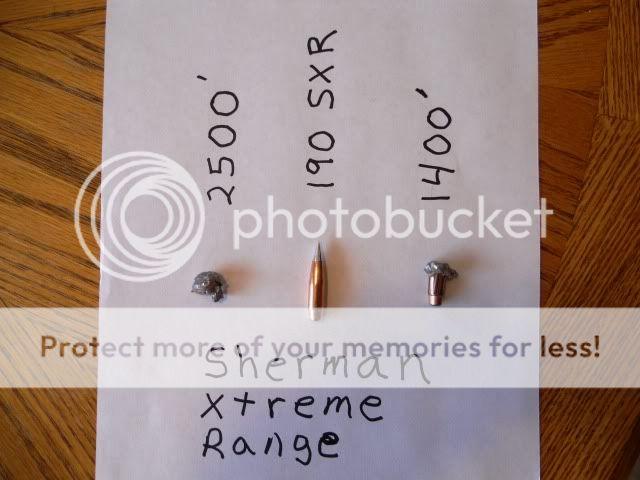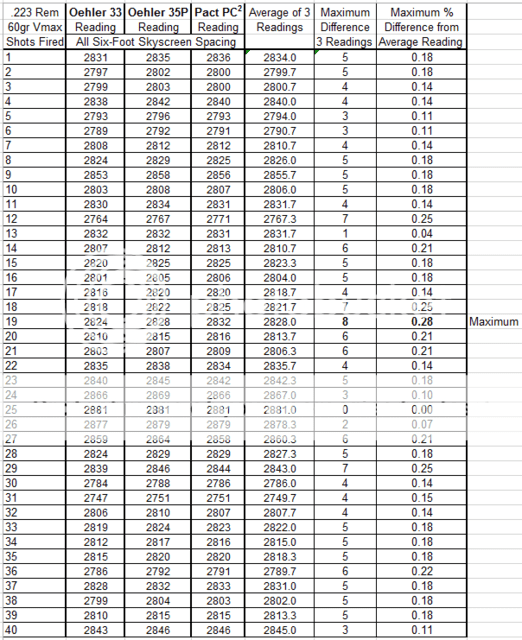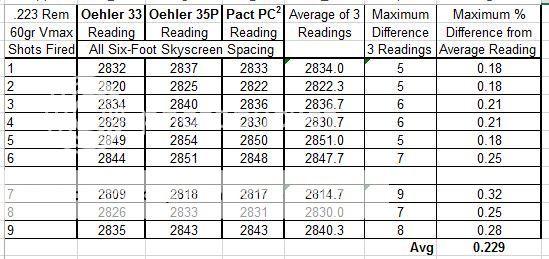Hi Jeff,
Review Mikecr's Post number 30, and my Post number 32 within this Thread.
It will be normal to obtain different readings if the skyscreens aren't mounted with the correct spacing. I mean that they have to be mounted with a separation distance that exactly matches the value that's been programmed into the 35P computer. When the bullets pass over the start and stop skyscreens, they trigger an electronic clock in the chronograph computer. The owner/operator of the chronograph has to program the chronograph for the actual separation distance of the two Primary skyscreens. With the Oehler 35P, the skyscreens can be mounted at various separation distances. The 35P computer must be programmed for the operator-selected distance by setting several small switches - per the owner's manual/instructions. The 35P computer comes shipped from the factory set up for a 4' Primary screen separation distance. 4' for the Primary skyscreens automatically means 2' of separation for the Proof skyscreens. You want to measure the separation distance between the skyscreens and ensure they're mounted to exactly match the 35P programmed separation distance. I use a 6' and 3' spacing distance with my 35P. The farther the separation distance, the less error that will be entered into the recorded velocities due to slight error that may exist in the mounted separation distance between the skyscreens. The drawback to very large separation distances is that it's much less convenient to pack around a skyscreen rail that's 10 feet long, than one that's 4 feet long. Oehler settled on the four foot long skyscreen rail as compromise for user convenience.
Let's see if I can illustrate how a greater separation distance between the skyscreens serves to increase the accuracy of the recorded bullet velocity with these examples:
Example 1) If the 35P computer is programmed for a 20 foot separation distance, but the Primary skyscreens are actually separated a distance of 20.03 feet, one should expect the recorded velocities to be slower than the true bullet velocity by this amount: [(20.03-20)/(20)]x(100) = 0.15%. A 0.15% error in recorded bullet velocity. If the true bullet velocity is 3000 feet/sec, this 0.15% error would cause the chronograph to record a velocity which is 99.85% of the true velocity. A velocity of 0.9985 x 3000 = 2995.5 feet/sec. An error of 4.5 feet/sec. Not a severe amount of error.
Example 2) On the other hand, if the 35P computer is programmed for a 4 foot skyscreen separation distance, but the Primary skyscreens are actually separated a distance of 4.03 feet, one should expect the recorded velocities to be slower than the true bullet velocity by this amount: [(4.03-4.0)/(4.0)]x(100) = 0.75%. Now we see a 0.75% error in recorded bullet velocity. In both this example, and the prior example, the skyscreens have been mounted too far apart by a distance of 0.03 feet. However with the 4 foot skyscreen spacing, the resultant error in recorded velocities is increased by a factor of 5. Now; a bullet with a true velocity of 3000 feet/sec will record a velocity which is 99.25% of its true velocity. The 35P will record a velocity of (0.9925) x 3000 = 2977.5 feet/sec. An error of 22.5 feet/sec.
You stated that the Primary and Proof velocities differed by ~ 20 feet/sec. If the Primary skyscreens are mounted either 0.03' closer than 4 feet or 0.03' farther than 4 feet, then the recorded velocities will be off by about 22.5 feet/sec. As they were in my Example 2) - above. 0.03 feet is equal to 0.36 inches. About 3/8".
If your friend's 35P is programmed for Primary skyscreen separation of 4', then the Proof skyscreens should be mounted exactly 2 feet apart. If the Proof skyscreens are mounted either 0.015' closer than 2' or 0.015' farther than 2', then the 35P will again record velocities which are in error by approximately 22.5 feet/sec.
Sorry if this is mind-numbing overkill. Forgive me, as I am an engineer by training and profession.
Bottom line is your friend's 35P skyscreens are mounted on his rail at distances which are either too far apart, too close together, or a combination of too close and too far - between the Primary screens and the Proof screens.
If you only have a single 35P chronograph to work with, my recommendation is to carefully mount the Primary skyscreens as exactly as possible to match the distance the 35P computer is programmed for. I measure from the leading edge of the first skyscreen to the leading edge of the 2nd skyscreen.
Next mount the middle Proof skyscreen exactly 1/2 of the distance programmed into the 35P. The Proof skyscreens are always exactly 1/2 the separation distance of the Primary skyscreens. Again measure from leading edge to leading edge of the Proof skyscreens.
After all three skyscreens are mounted securely with exactly the correct separations - shoot over the skyscreens. At this point there should be very little difference in the recorded velocities. And there's no certain way to know which velocity is closer to the true velocity, unless you also have another unit which is known to be calibrated and certified to read the exact true velocities. But - you CAN know that the Primary channel is likely to have less error than the Proof channel, because the Primary skyscreens are separated twice as far apart as the Proof skyscreens.
So - IF your Primary velocities are reading slightly faster than the Proof velocities, DECREASE the separation distance between the middle Proof skyscreen and the first Primary skyscreen a little bit until the Primary Channel and the Proof Channel are in very close agreement.
IF your Primary velocities are reading slightly slower than the Proof velocities, INCREASE the separation distance between the middle Proof skyscreen and the first Primary skyscreen a little bit until the Primary Channel and the Proof Channel are in very close agreement.
By changing the location of the Proof (middle) skyscreen on the skyscreen rail, you will be able to calibrate the Proof channel to record virtually the same velocities as the Primary channel.
With my setup, I had three separate chronographs with 7 different skyscreens. Two skyscreens each for the Oehler 33 and the PACT. Three skyscreens for the Oehler 35P. I very carefully measured and mounted the skyscreens to the distances programmed into each of the three different chronographs. When I shot some 22 LR rounds over my triplicate Chrono setup, the velocities being recorded from all three units was just about identical - except that the 35P Proof Channel was recording about 6-7 feet/sec faster than the rest. So I tweaked the middle skyscreen of the 35P farther apart until the velocity from the 35P Proof channel matched the other three recorded velocities. Because I have three units and all three recorded virtually identical velocities after carefully mounting the skyscreens, I have some added confidence that the velocities being recorded are very close to the true bullet velocity. If I had six units all running at the same time, and the six units all recorded the same velocity after setup, my confidence could be about twice as great as with the three units. And so on and so on...
Did my best to explain this. My back, wrists and fingers are failing me, so I need a break! I hope this helps explain what the problem is, and what the solution is. If you were consistently seeing a 20 feet/sec difference between the two 35P channels, then it's a sure bet that the screens aren't mounted to the exactly correct separation distances.
Am I long-winded or WHAT??? Time for a glass of wine. But do let me know if you have questions. I'll try to help - to the best of my ability.
Review Mikecr's Post number 30, and my Post number 32 within this Thread.
It will be normal to obtain different readings if the skyscreens aren't mounted with the correct spacing. I mean that they have to be mounted with a separation distance that exactly matches the value that's been programmed into the 35P computer. When the bullets pass over the start and stop skyscreens, they trigger an electronic clock in the chronograph computer. The owner/operator of the chronograph has to program the chronograph for the actual separation distance of the two Primary skyscreens. With the Oehler 35P, the skyscreens can be mounted at various separation distances. The 35P computer must be programmed for the operator-selected distance by setting several small switches - per the owner's manual/instructions. The 35P computer comes shipped from the factory set up for a 4' Primary screen separation distance. 4' for the Primary skyscreens automatically means 2' of separation for the Proof skyscreens. You want to measure the separation distance between the skyscreens and ensure they're mounted to exactly match the 35P programmed separation distance. I use a 6' and 3' spacing distance with my 35P. The farther the separation distance, the less error that will be entered into the recorded velocities due to slight error that may exist in the mounted separation distance between the skyscreens. The drawback to very large separation distances is that it's much less convenient to pack around a skyscreen rail that's 10 feet long, than one that's 4 feet long. Oehler settled on the four foot long skyscreen rail as compromise for user convenience.
Let's see if I can illustrate how a greater separation distance between the skyscreens serves to increase the accuracy of the recorded bullet velocity with these examples:
Example 1) If the 35P computer is programmed for a 20 foot separation distance, but the Primary skyscreens are actually separated a distance of 20.03 feet, one should expect the recorded velocities to be slower than the true bullet velocity by this amount: [(20.03-20)/(20)]x(100) = 0.15%. A 0.15% error in recorded bullet velocity. If the true bullet velocity is 3000 feet/sec, this 0.15% error would cause the chronograph to record a velocity which is 99.85% of the true velocity. A velocity of 0.9985 x 3000 = 2995.5 feet/sec. An error of 4.5 feet/sec. Not a severe amount of error.
Example 2) On the other hand, if the 35P computer is programmed for a 4 foot skyscreen separation distance, but the Primary skyscreens are actually separated a distance of 4.03 feet, one should expect the recorded velocities to be slower than the true bullet velocity by this amount: [(4.03-4.0)/(4.0)]x(100) = 0.75%. Now we see a 0.75% error in recorded bullet velocity. In both this example, and the prior example, the skyscreens have been mounted too far apart by a distance of 0.03 feet. However with the 4 foot skyscreen spacing, the resultant error in recorded velocities is increased by a factor of 5. Now; a bullet with a true velocity of 3000 feet/sec will record a velocity which is 99.25% of its true velocity. The 35P will record a velocity of (0.9925) x 3000 = 2977.5 feet/sec. An error of 22.5 feet/sec.
You stated that the Primary and Proof velocities differed by ~ 20 feet/sec. If the Primary skyscreens are mounted either 0.03' closer than 4 feet or 0.03' farther than 4 feet, then the recorded velocities will be off by about 22.5 feet/sec. As they were in my Example 2) - above. 0.03 feet is equal to 0.36 inches. About 3/8".
If your friend's 35P is programmed for Primary skyscreen separation of 4', then the Proof skyscreens should be mounted exactly 2 feet apart. If the Proof skyscreens are mounted either 0.015' closer than 2' or 0.015' farther than 2', then the 35P will again record velocities which are in error by approximately 22.5 feet/sec.
Sorry if this is mind-numbing overkill. Forgive me, as I am an engineer by training and profession.
Bottom line is your friend's 35P skyscreens are mounted on his rail at distances which are either too far apart, too close together, or a combination of too close and too far - between the Primary screens and the Proof screens.
If you only have a single 35P chronograph to work with, my recommendation is to carefully mount the Primary skyscreens as exactly as possible to match the distance the 35P computer is programmed for. I measure from the leading edge of the first skyscreen to the leading edge of the 2nd skyscreen.
Next mount the middle Proof skyscreen exactly 1/2 of the distance programmed into the 35P. The Proof skyscreens are always exactly 1/2 the separation distance of the Primary skyscreens. Again measure from leading edge to leading edge of the Proof skyscreens.
After all three skyscreens are mounted securely with exactly the correct separations - shoot over the skyscreens. At this point there should be very little difference in the recorded velocities. And there's no certain way to know which velocity is closer to the true velocity, unless you also have another unit which is known to be calibrated and certified to read the exact true velocities. But - you CAN know that the Primary channel is likely to have less error than the Proof channel, because the Primary skyscreens are separated twice as far apart as the Proof skyscreens.
So - IF your Primary velocities are reading slightly faster than the Proof velocities, DECREASE the separation distance between the middle Proof skyscreen and the first Primary skyscreen a little bit until the Primary Channel and the Proof Channel are in very close agreement.
IF your Primary velocities are reading slightly slower than the Proof velocities, INCREASE the separation distance between the middle Proof skyscreen and the first Primary skyscreen a little bit until the Primary Channel and the Proof Channel are in very close agreement.
By changing the location of the Proof (middle) skyscreen on the skyscreen rail, you will be able to calibrate the Proof channel to record virtually the same velocities as the Primary channel.
With my setup, I had three separate chronographs with 7 different skyscreens. Two skyscreens each for the Oehler 33 and the PACT. Three skyscreens for the Oehler 35P. I very carefully measured and mounted the skyscreens to the distances programmed into each of the three different chronographs. When I shot some 22 LR rounds over my triplicate Chrono setup, the velocities being recorded from all three units was just about identical - except that the 35P Proof Channel was recording about 6-7 feet/sec faster than the rest. So I tweaked the middle skyscreen of the 35P farther apart until the velocity from the 35P Proof channel matched the other three recorded velocities. Because I have three units and all three recorded virtually identical velocities after carefully mounting the skyscreens, I have some added confidence that the velocities being recorded are very close to the true bullet velocity. If I had six units all running at the same time, and the six units all recorded the same velocity after setup, my confidence could be about twice as great as with the three units. And so on and so on...
Did my best to explain this. My back, wrists and fingers are failing me, so I need a break! I hope this helps explain what the problem is, and what the solution is. If you were consistently seeing a 20 feet/sec difference between the two 35P channels, then it's a sure bet that the screens aren't mounted to the exactly correct separation distances.
Am I long-winded or WHAT??? Time for a glass of wine. But do let me know if you have questions. I'll try to help - to the best of my ability.
Last edited:



